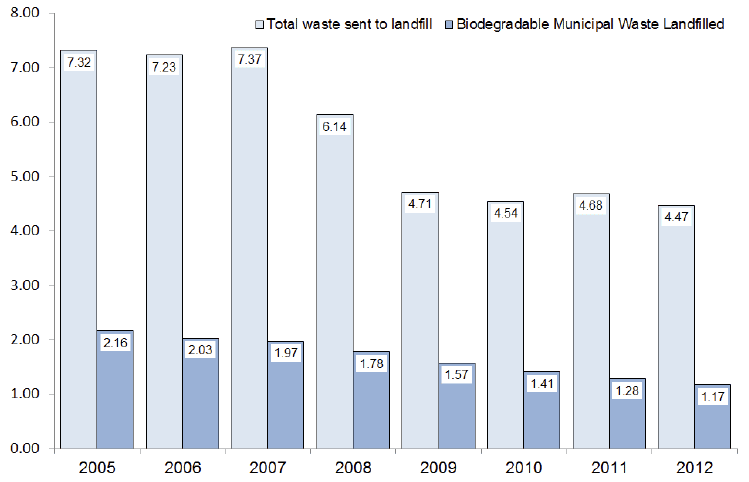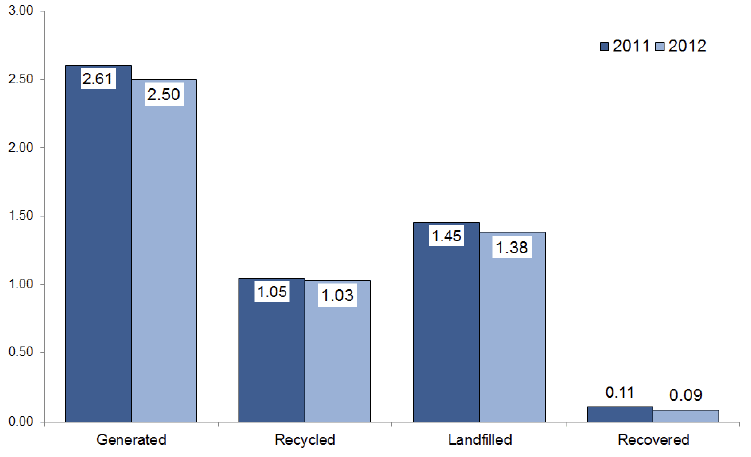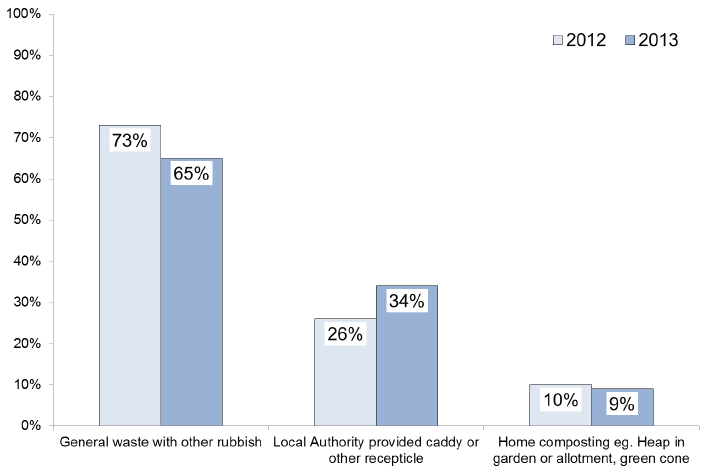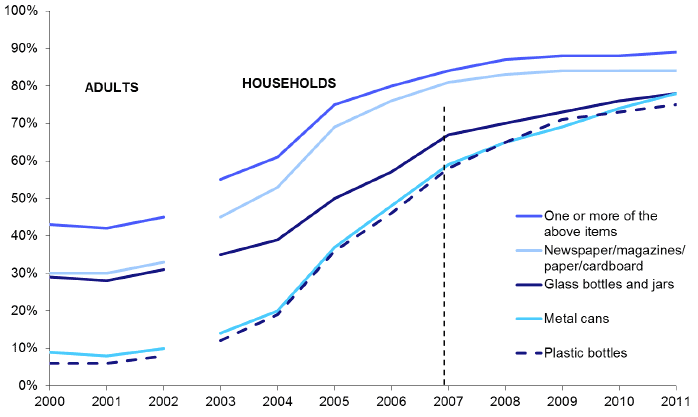Key Scottish Environment Statistics 2014
This publication aims to provide an easily accessible reference document which offers information on a wide range of environmental topics. It covers key datasets on the state of the environment in Scotland, with an emphasis on the trends over time wherever possible. The data are supplemented by text providing brief background information on environmental impacts, relevant legislation and performance against national and international targets.
This document is part of a collection
Waste & Recycling
Waste Sent to Landfill: 2000-2012
Million tonnes

Scotland's Zero Waste Plan[1] 2010 sets a maximum 5% target for all waste sent to landfill by 2025. The disposal of waste to landfill is at the bottom of the waste hierarchy[2]. It results in the loss of valuable materials and generates pollutants. In particular, biodegradable waste such as paper, food and garden waste emit methane, a potent greenhouse gas, alongside carbon dioxide.
In 2012, 4.47 million tonnes were landfilled[3]. Biodegradable Municipal Waste (BMW)[4] landfilled accounted for 1.17 million tonnes in 2012. Between 2005 and 2012, total waste landfilled decreased by 39%, and BMW landfilled decreased by 46%.
The Scottish Government set a target for the maximum amount of BMW sent to landfill of 2.7 million tonnes by 2010 as Scotland's contribution to UK targets set in the EU Landfill Directive.[5],[6] Landfill Tax, introduced in 1996 in order to discourage the disposal of waste to landfill, increased incrementally to £64 per tonne for biodegradable waste for 2012/13, and is £80 per tonne for 2014/15. The lower rate for inactive waste has remained at £2.50 per tonne since 2008.
Source: Scottish Environment Protection Agency / Metadata
Million Tonnes

Waste prevention, minimisation and re-use are at the top of the waste hierarchy[2] while landfill is at the bottom. Recognition for this is given in Scotland's Zero Waste Plan[1]. The strong historic dependence on landfill for waste management in Scotland is unsustainable since it involves the depletion of both renewable and finite natural resources. In addition, extracting and processing raw materials may consume large quantities of energy, release pollutants and destroys landscapes and ecosystems.
The national household waste recycling rate in 2012 was 41.2%, increasing from 40.1% in 2011. The total amount of household waste generated decreased, from 2.61 tonnes in 2011 to 2.50 tonnes in 2012. As a result of this decrease in the amount of household waste generated, the overall tonnage of recycled material also decreased, despite the increased recycling rate.
As part of the Zero Waste Plan[1], the Scottish Government has set targets for 50% of household waste to be recycled, composted or prepared for reuse by 2013; 60% by 2020 and 70% of all waste (not just household) by 2025.
Source: Scottish Environment Protection Agency / Metadata
Food Waste Disposal: 2012 - 2013
% surveyed who reported methods used to dispose of food waste in past week

Zero Waste Scotland estimated that 566,000 tonnes of food are thrown away by households in Scotland every year[7]. Food is an essential resource, and wasted food costs households money and reduces the self sufficiency of the economy. Some food waste cannot be avoided however, but can instead be processed to produce nutrient rich fertilisers and bio-gas - a low carbon energy source. Home composting of food wastes also produces fertiliser. Most local authorities in Scotland now operate a food waste caddy system which allows households to separate their food waste for separate collection. Diverting food waste from landfill is important in avoiding generation of greenhouse gases.
From 2012, respondents in the Scottish Household Survey[8] have been asked how they disposed of food waste in the previous week and were given three options, of which they could select more than one[9]. In 2013, 34% of households used local authority provided food waste caddies to dispose of their household waste compared with 26% in 2012. There has been an associated decline in people throwing food out with general waste, from 65% in 2012 compared to 73% in 2012. There has been a 1% decline in the percentage of people using home composting methods, but this change is not statistically significant.
The diversion of food waste helps work towards the EU target of no more than 1.8 million tonnes of biodegradable municipal waste sent to landfill by 2013 and less than 1.26 million tonnes by 2020[6].
Source: Scottish Government / Metadata
Waste Recycling Behaviour: 2000-2011
% surveyed who reported recycling waste items in the past month[10],[11],[12]

Re-using and recycling waste are key to sustainable development and Zero Waste objectives. The Scottish Household Survey[8] provides information on recycling behaviour amongst households in Scotland. Households were asked which, if any, of a selection of certain waste items they had recycled from home in the past month. Before 2003, the same question was asked of a random adult in the household.
In 2011, 89% of households surveyed said they had recycled one or more of the tabulated items in the past month, increasing from 55% in 2003. In 2011, 84% had recycled paper and card, 75% had recycled plastic bottles, and 78% had recycled both metals cans and glass bottles and jars. Since 2003, the percentage of households recycling waste has increased for each item in the survey.
There is a clear relationship between the type of property in which households live and the amount of recycling. In 2011, 94% of households living in a house or bungalow recycled at least one of the items in the past month compared with 80% living in flats. This question was suspended from the survey for 2012 and 2013. The next round of responses to the recycling question will be reported on in 2015.
Source: Scottish Government / Metadata
Contact
Email: Kirsty Ciclitira
There is a problem
Thanks for your feedback